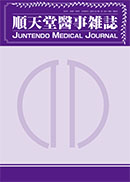Volume 60, Issue 3
Displaying 1-19 of 19 articles from this issue
- |<
- <
- 1
- >
- >|
Contents
-
2014Volume 60Issue 3 Pages 175
Published: 2014
Released on J-STAGE: August 19, 2014
Download PDF (3681K)
Special Reviews: 332nd Triannual Meeting of the Juntendo Medical Society “Farewell Lectures of Retiring Professor”
-
2014Volume 60Issue 3 Pages 176-177
Published: 2014
Released on J-STAGE: August 19, 2014
Download PDF (420K) -
2014Volume 60Issue 3 Pages 178-184
Published: 2014
Released on J-STAGE: August 19, 2014
Download PDF (7522K) -
2014Volume 60Issue 3 Pages 185-189
Published: 2014
Released on J-STAGE: August 19, 2014
Download PDF (2920K) -
2014Volume 60Issue 3 Pages 190-192
Published: 2014
Released on J-STAGE: August 19, 2014
Download PDF (624K) -
2014Volume 60Issue 3 Pages 193-198
Published: 2014
Released on J-STAGE: August 19, 2014
Download PDF (7505K)
Current Topics: Paradigm Shift in Cancer Research, Treatment and Education
-
2014Volume 60Issue 3 Pages 199
Published: 2014
Released on J-STAGE: August 19, 2014
Download PDF (405K) -
2014Volume 60Issue 3 Pages 200-209
Published: 2014
Released on J-STAGE: August 19, 2014
Download PDF (513K) -
2014Volume 60Issue 3 Pages 210-219
Published: 2014
Released on J-STAGE: August 19, 2014
Download PDF (1295K) -
2014Volume 60Issue 3 Pages 220-223
Published: 2014
Released on J-STAGE: August 19, 2014
Download PDF (1256K) -
2014Volume 60Issue 3 Pages 224-233
Published: 2014
Released on J-STAGE: August 19, 2014
Download PDF (4873K) -
2014Volume 60Issue 3 Pages 234-237
Published: 2014
Released on J-STAGE: August 19, 2014
Download PDF (446K)
Original Articles
-
2014Volume 60Issue 3 Pages 238-244
Published: 2014
Released on J-STAGE: August 19, 2014
Download PDF (12328K) -
2014Volume 60Issue 3 Pages 245-250
Published: 2014
Released on J-STAGE: August 19, 2014
Download PDF (526K)
Lecture Notes
-
2014Volume 60Issue 3 Pages 251-257
Published: 2014
Released on J-STAGE: August 19, 2014
Download PDF (494K)
Publication List
-
2014Volume 60Issue 3 Pages 258-277
Published: 2014
Released on J-STAGE: August 19, 2014
Download PDF (636K)
Other articles
-
2014Volume 60Issue 3 Pages 278-279
Published: 2014
Released on J-STAGE: August 19, 2014
Download PDF (407K) -
2014Volume 60Issue 3 Pages 280-281
Published: 2014
Released on J-STAGE: August 19, 2014
Download PDF (411K) -
2014Volume 60Issue 3 Pages 282
Published: 2014
Released on J-STAGE: August 19, 2014
Download PDF (506K)
- |<
- <
- 1
- >
- >|
